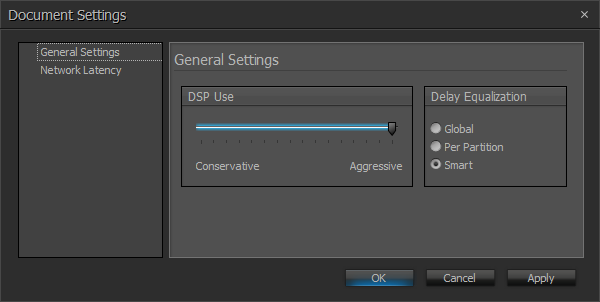Delay Equalization
Some signal paths through a Tesira system can take longer to process than others. Tesira includes a mechanism called Delay Equalization, which maintains synchronization between signals that have different propagation times.
For example, consider a simplified Tesira system with two inputs and two outputs. The signal from the first input passes through many processing blocks and several AVB hops before it gets to the first output. The signal from the second output travels directly to the second output without going through any processing blocks or AVB hops. Clearly, the signal from the first input will take longer to process than the signal from the second input.
Without delay equalization, the signal from the second input would be heard slightly before the signal from the first input. This can be undesirable in many cases, particularly if both outputs can be heard simultaneously in the same acoustic space. Delay equalization solves this problem by inserting a small delay on the second input signal such that it reaches the output at the same time as the first input signal.
Delay Equalization Groups
Most audio and video input and output blocks are assigned to a Delay Equalization Group. Each I/O block’s Delay Equalization Group can be found in its Property Sheet.
Three default groups are always available:
- None - If required any block can be unassigned from a default or user-defined group. (meaning it will be excluded from delay equalization calculations.)
- Default - Each audio I/O block (excludes AEC Blocks) is initially assigned to the Default group
- Default AEC - Each audio AEC block is initially assigned to the Default AEC group
- Default Video - Each Video block is initially assigned to the Default Video group
Signals originating from input blocks that are in the same group will be synchronized up until the point they encounter a block with multiple inputs (e.g., mixers, routers, duckers, room combiners). Signals which feed output blocks that are in the same group are assumed to feed the same acoustic space, and will be synchronized from when they output a mixer/router block until they reach the output blocks.
Assigning an input block to the same group as an output block is allowed, but internally they will be treated as different groups. Input signals are only synchronized with other input signals, and output signals are only synchronized with other output signals.
User-defined Delay Equalization Groups can be added in the Delay Equalization Groups dialog. Once a user-defined group is created, any I/O block can be assigned to it via its Property Sheet.
Delay Equalization Modes
Tesira software can operate in one of three Delay Equalization Modes, which define how Delay Equalization Groups in different partitions interact with one another.
In some cases, making changes to one partition can affect the delay equalization requirements of another (otherwise unchanged) partition. In this case, both partitions will need to be updated when the configuration is sent, which means that audio will be interrupted in both partitions. A warning will be displayed during compilation if this situation arises. Managing Delay Equalization Groups and/or selecting the appropriate Delay Equalization Mode can prevent this situation from occurring when it is undesirable.
The Delay Equalization Mode for a configuration file can be selected in the Document Settings dialog.
Delay Equalization Modes only affect the behavior of I/O blocks that are assigned to the Default Delay Equalization Group; I/O blocks that are assigned to user-defined Delay Equalization Groups will always be synchronized, regardless of the currently selected mode. Similarly, I/O blocks that are assigned to the “None” group will not be synchronized in any mode. There are three modes: Global, Per Partition, and Smart.
Global Mode
The Global Delay Equalization Mode ensures that all I/O blocks in the same Delay Equalization Group (except the “None” group) are synchronized, even if they are in different partitions.
Per Partition Mode
The Per Partition Delay Equalization Mode ensures that signals in different partitions are not synchronized. In this mode, I/O blocks in different partitions will not be synchronized with one another when they are all assigned to the Default group. In other words, this mode only allows delay equalization to operate within single partitions. The only exception is for blocks that are assigned to user-defined Delay EQ groups, which will be synchronized in this mode.
Smart Mode
The Smart Delay Equalization Mode is the middle ground between the Global and Per Partition modes. In this mode, when I/O blocks in different partitions are in the Default group, they will be synchronized only if the signals associated with those I/O blocks are connected to a common mixer/router block. If the I/O blocks don’t interact with one another, they will not be synchronized. Note that this mode only affects blocks in the Default group; blocks in the same user-defined group will always be synchronized, regardless of whether they interact with one another.
